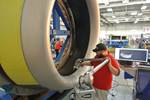Russia exits from Comac CR929 program, MS-21 experiences delays
Reports confirm Russia’s step away from the CR929 widebody aircraft and impending delays in MS-21 deliveries, long-term consequences from Western-imposed sanctions.
On Aug. 22, Aviation Weekly released an announcement that confirms Russia has withdrawn from the Comac CR929 widebody aircraft project with China. It is believed this is due to long-term consequences following the Ukraine invasion about 18 months ago. Reported delays to the Irkut (Moscow, Russia) MS-21 single-aisle commercial aircraft, owned by United Aircraft Corp. (UAC, Moscow) are suggesting additional challenges. Both aircraft programs use a healthy amount of composite materials.
While China has not commented on the change of plans for the CR929, for months reports have indicated that the region had decided to pursue the widebody on its own. According to Aviation Weekly, if these reports hold some truth, they may stem from the fact that keeping Russia on, after Western-posed sanctions, could pose their own challenges to lifting the program off the ground; the CR929 has already “accumulated years of delays and is not expected to enter service until well after 2030 due to lengthy negotiations about sharing work and intellectual property.” China currently has no sanctions on Russia and the China-Russia Commercial Aircraft International Corp. (CRAIC), formed in 2017, seems to still be intact.
UAC CEO Yury Slyusar notes that Russia still hopes to remain involved in the Comac CR929 program, and plans to continue as a “normal supplier and builder of the composite wing, PD-35 engines and other subsystems for the aircraft.” However, it is still unclear how Western suppliers previously working on the program — Eaton, Honeywell, Liebherr, RTX, Safran, Thales, Zodiac Aerospace and an engine manufacturer — could take part. Aviation Weekly cites that, in addition to the Russian PD-35 engine, China plans to use Aero Engine Corp. of China (AECC) CJ-2000 currently in development.
A widebody similar in size to the Airbus A330, the CR929 is designed to carry between 258 and 320 passengers with a range of up to 12,000 kilometers.
The MS-21 (also known as the MC-21) program’s timeline has also slipped, another direct result of Western suppliers withdrawal. The Russian-financed program was “expected to hand over the MC-21s in 2024 and roll out 270 of them through 2030.” Russian manufacturers have been given additional time to substitute imported components, including actuators, avionics and air conditioning. Russian PD-14 turbofans and a Russian-made infused composite wing were approved in December 2022.
“We hope that the first six aircraft will be handed over to Aeroflot [a subsidiary of Rossiya Airlines] in the beginning of 2025,” Anatoly Gaidansky, Yakovlev’s first deputy general director, acknowledged in a podcast with the Moscow Aviation Institute on Aug. 13.
An MC-21 prototype is under development, with “70% substituted Western-made equipment,” and is expected to beginning in December 2023. The fully import-substituted version, dubbed MC-21-310RUS, is to make its first flight in April 2024 and then receive its supplemental type certificate by the end of that year.
Related Content
-
TU Munich develops cuboidal conformable tanks using carbon fiber composites for increased hydrogen storage
Flat tank enabling standard platform for BEV and FCEV uses thermoplastic and thermoset composites, overwrapped skeleton design in pursuit of 25% more H2 storage.
-
Sinonus launches energy-storing carbon fiber
Swedish deep-tech startup Sinonus is launching an energy-storing composite material to produce efficient structural batteries, IoT devices, drones, computers, larger vehicles and airplanes.
-
Partners recycle A350 composite production waste into adjustable-length rods for MFFD
Herone, Spiral RTC, Teijin Carbon Europe and Collins Aerospace Almere recycle A350 thermoplastic composite clips/cleats waste into rods for the all-thermoplastic composite Multifunctional Fuselage Demonstrator’s crown.

















